 W
WEomys is an extinct genus of eomyid rodent from the late Oligocene of France, Germany, Spain, and possibly Turkey. The species Eomys quercyi is the earliest known gliding rodent.
 W
WThe Quercy Phosphorites Formation is a geologic formation and Lagerstätte in Occitanie, southern France. It preserves fossils dating back to the Paleogene period, or MP16 to MP28 zones of the European land mammal age classification, ranging from approximately 38 to 25 Ma.
 W
WCynodictis, is an extinct amphicyonid carnivoran which inhabited Eurasia from the Late Eocene subepoch to the Early Oligocene subepoch living from 37.2—28.4 million years ago, existing for approximately 8.8 million years .
 W
WEomys is an extinct genus of eomyid rodent from the late Oligocene of France, Germany, Spain, and possibly Turkey. The species Eomys quercyi is the earliest known gliding rodent.
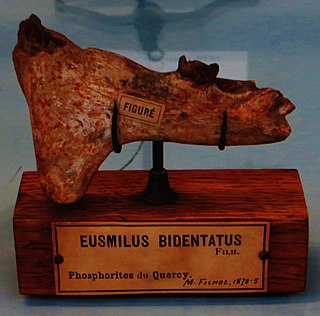 W
WEusmilus is a prehistoric genus of nimravid that lived in Europe during the Late Eocene to Early Oligocene epochs.
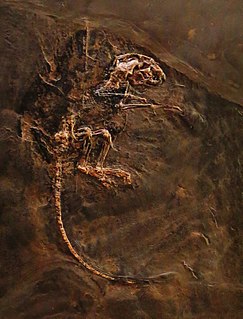 W
WHeterohyus is an extinct genus of apatemyid from the early to late Eocene. A small, tree-dwelling creature with elongated fore- and middle fingers, in these regards it somewhat resembled a modern-day aye-aye. Three skeletons have been found at the early Eocene site at Messel Pit, Germany
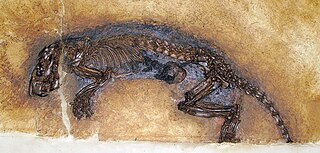 W
WMasillamys is an extinct genus of rodent. It was named in 1954 by Tobien based on fossils found in the Quercy Phosphorites Formation. It is considered to be a sister genus to the Hartenbergeromys, Lophiparamys, Mattimys, Microparamys, Pantrogna, Sparnacomys, and Strathcona genera.
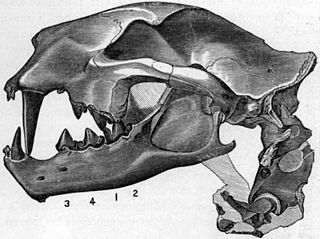 W
WNimravus is an extinct genus of "false" saber-toothed cat in the family Nimravidae, that was endemic to North America during the Oligocene epoch 33.3—26.3 mya, existing for approximately 7 million years . Not closely related to true saber-toothed cats, they evolved a similar form through parallel evolution. Fossils have been uncovered in the western U.S. from Oregon to southern California and Nebraska.
 W
WPalaeogale is an extinct genus of carnivorous mammal known from the Late Eocene, Oligocene, and Early Miocene of North America, Europe, and Eastern Asia. A small carnivore often associated with the mustelids, Palaeogale might have been similar to living genets, civets, and linsangs.
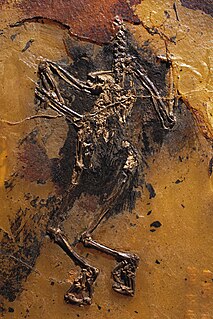 W
WPalaeoglaux is a genus of fossil owls from the Eocene epoch. The two known species are P. perrierensis from the Upper Eocene of Quercy, France, and P. artophoron from the Middle Eocene Messel shales, Germany. The holotype of P. perrierensis is a partial left coracoid in the Collection Université Montpellier, accession number PRR 2585. The four paratypes are the distal part of a left humerus (PRR2591), the proximal part of a left ulna, the distal part of a left ulna, and the distal part of a right tarsometatarsus. The type specimen of P. artophoron is a fossil slab and counterslab containing most of the postcranial skeleton and some feather impressions. This specimen is in the collection of the Forschunginstitut Senckenberg, accession number SMF-ME 1144 A and B.
 W
WPalaeopython is an extinct genus of snake from the Eocene of Europe. The genus has been used to refer to large Western and Central European snake vertebrae from the Eocene. P. cadurcensis and P. filholii originate from France; P. ceciliensis originates from Germany; and P. helveticus originates from Switzerland. A species known from multiple well-preserved specimens found in the Messel Pit of Germany, P. fischeri, was named by Stephan Schaal in 2004, but examination of the genus showed that it represented a distinct lineage; it was renamed Eoconstrictor fischeri in 2020. An additional species, P. sardus, was described in 1901 by Alessandro Portis from the Middle Miocene of Monte Albu. However, a reevaluation of the holotype specimen of this species revealed it to actually belong to an indeterminate acanthomorph fish.
 W
WPalaeovaranus is an extinct genus of varanoid lizards from the Late Eocene of France and Germany. It contains two species, Palaeovaranus cayluxensis and Palaeovaranus giganteus. The genus was first named by Henri Filhol in 1877, but he had named the species Palaeovaranus cayluxi earlier as Palaeosaurus cayluxi in 1873, and as Necrosaurus cuxleyi in 1876 after it was discovered that Palaeosaurus was preoccupied. However, he failed to provide any kind of valid description, which renders Karl Alfred Ritter von Zittel's 1887 description of the taxon as the valid authority on its validity. Despite this, the name Necrosaurus was widely used in the literature afterwards.
 W
WPeratherium is a genus of metatherian mammals in the family Herpetotheriidae that lived in Europe and Africa from the Early Eocene to the Early Miocene. Species include the following:Peratherium africanum Peratherium antiquum Peratherium bretouense Peratherium cayluxi Peratherium constans Peratherium cuvieri Peratherium elegans Peratherium lavergnense Peratherium matronense Peratherium monspeliense Peratherium perrierense Peratherium sudrei
 W
WStrigogyps is an extinct genus of prehistoric bird from the Middle Eocene to Early Oligocene of France and Germany. It was probably around the size of a large chicken or a guan, weighing not quite 1 kilogram (2.2 lb). Apparently, as indicated by the ratio of lengths of wing to leg bones, S. sapea was flightless. Its legs were not adapted to running, so it seems to have had a walking lifestyle similar to trumpeters. Unlike other Cariamiformes, which appear to have been mostly carnivorous, Strigogyps specimens suggest a herbivorous diet.
 W
WXenomorphia is an extinct genus of parasitoid wasp comprising two species: X. resurrecta and X. handschini. The generic name is in reference to the parasitic Xenomorph creature starring in the Alien franchise. The wasp's first fossils were discovered in Oligocene (Chattian) aged phosphorite mines located in the former Quercy province of France, the remains of 55 ancient fly (Phoridae) pupae were found preserved with Xenomorphia wasps inside of them, recording a parasitic relationship between the two insects. Along with the two Xenomorphia wasp species, two other new wasp taxa were identified, Coptera anka, and Palaeortona quercyensis.